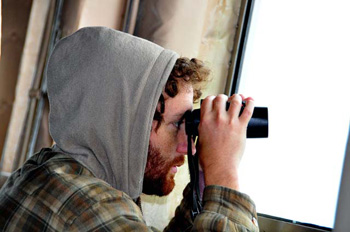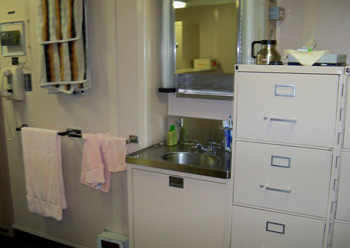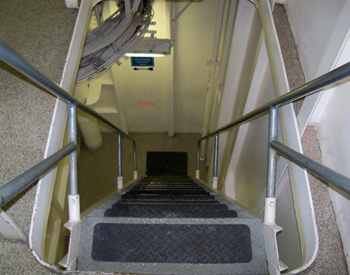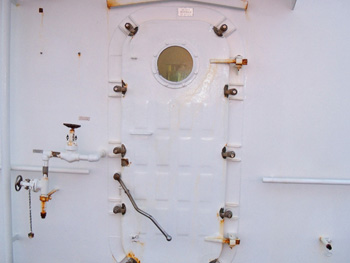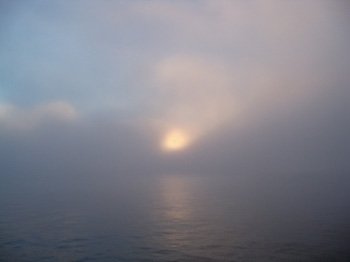Dear Pat, We're sending our questions to you and are eagerly awaiting your responses. We are checking the website daily to see how your expedition is coming together. I think this will be a wonderful experience for all involved. I hope you are enjoying weather that is pleasing to the soul. FIFTH GRADE QUESTIONSHOW DEEP ARE THE DEEPEST WATERS THAT YOU WILL BE INVESTIGATING? Answered by Dr. Bob, Chief Scientist: The Arctic Ocean is very unique in that much of it is very shallow. In fact, the continental shelves north of the Arctic Circle are some of the widest in the world. So far on this trip we have stayed in the Chukchi Sea, just to the north of Bering Strait, which only gets as deep as 50 meters (how many feet is that?). This may seem deep, but compared to a place like Greenland (where the shelf can be as deep as 400 meters) it is shallow. However, before our trip is over we will go out into the middle of the Canada Basin where it gets as deep as 3,000 meters! Even when it's that deep we can still lower our instruments all the way to the sea floor and collect interesting measurements. The water down there is very old and stagnant. It would be awfully cool to take a deep submersible down that deep, don't you think? AT WHAT DEPTH DO THE SURFACE CURRENTS CHANGE INTO DEEP OCEAN CURRENTS AND IS THERE A DIFFERENCE IN DIRECTION OF THE SURFACE AND DEEP OCEAN CURRENTS? Answered by Dr. Bob, Chief Scientist: What a great question! In some areas that we'll visit on our voyage, the water near the surface will be moving very slowly while the water near the bottom is flowing quite quickly. But in other areas the opposite is true. Why? When the wind blows it tends to move water that is closest to the surface. But during winter when the ice forms, some of the salt gets "rejected" out of the ice and the extra salt in the surface water underneath makes it very dense and heavy. This heavy water then sinks and can flow along the bottom. But what happens when the wind blows at the same time as the ice forms? In that case things can get very complicated, and that's one of the things that we are studying! WHAT KIND OF SEA ANIMALS/ORGANISMS ARE YOU EXPECTING TO FIND AND WHAT INFORMATION ARE YOU INTERESTED IN LEARNING ABOUT THESE ANIMALS/ORGANISMS? Answered by Sharon Nieukirk, Marine Mammal Biologist: We have already seen gray whales, lots of birds and many seals. I also hope to see bowhead whales, beluga whales, walrus and polar bears!
As a seabird observer, I'm expecting to see about 20 to 25 different species that occur around here. By identifying and counting the different birds, it tells us how healthy their populations are, and if the birds are showing up in different areas than we've seen in the past. Birds usually go where the best conditions and food are, so as the environment changes in the arctic we watch closely to see what the birds are doing! Answered by Josh Jones, Marine Mammal Researcher: Thank you for your excellent question! Josh Jones here. I'm one of the marine mammal researchers on board the HEALY right now. I can tell you about the marine mammals that we might find along our trackline in the Beaufort and Chukchi seas. They fall into two categories: cetaceans (the order of animals the includes whales, dolphins, and porpoises) and pinnipeds (the order of animals that includes seals, sea lions and walrus). Of the whales and pinnipeds that use this area, there are some that travel here in the summer to feed and some that live here all year. The species that live in the Arctic all year are specially adapted to live in and around sea ice. These are bowhead and beluga whales and also ringed seals, walrus, spotted seals, and bearded seals. We can talk later about how these species survive and thrive in an ice-covered ocean if you're interested. Marine mammal species that migrate here from other places include gray whales and ribbon seals. Turns out that many walrus, bearded seals, and probably ringed seals come up from the Bering Sea in Summer, following the southern edge of the polar pack ice as it melts and retreats northward every year. Researchers are also starting to see humpback whales and even orcas (killer whales) in the Arctic. This could mean that their ranges are expanding or just that we happened not to see them until recently. So far on this expedition we've seen lots of bearded seals and unidentified smaller seals (probably ringed or spotted seals). We've also seen numerous gray whales. These whales swim here every year from their breeding grounds all the way down in Mexico. That's about a 5000 mile swim each way! You have to imagine that it must be a pretty good meal to come all this way for. The main thing that we're interested in learning about these marine mammals is how and when they use this area. Knowing what locations are most important at what times of year for each species adds to our understanding of what makes the Beaufort and Chukchi seas special and also helps us to decide when and where we need to take extra care in planning human activities, like oil exploration. Studying when and where the various marine mammals are here and comparing that to satellite images of sea ice might also help us to understand how climate change is affecting these animals. For some, less ice might be a good thing. For others it might cause problems. Another thing that we want to learn about each of these species is what kind of sounds they make and how they might be using these sounds to communicate. We know that all marine mammals make sounds. We can identify many species just from their sounds, like the way you can tell the difference between the sound of a crow and a sparrow when you're walking in the park. I think that the marine mammals up here make some of the most beautiful sounds of any animal. To study the sounds of the whales and seals here, we put recorders on the seafloor that can record sound for up to a year. In fact, during the last two days we've deployed four of them. Next year we hope to return to the same spots to get the sounds the instruments collected during 2010 and 2011. Who knows what we'll find. Stay tuned! Josh PS: If you want to hear and see the sounds of marine mammals from here and from all over the world, check out our website called Whales: Voices in the Sea (www.voicesinthesea.org) OVERALL, DO ANIMALS THAT LIVE IN THE FRIGID ARCTIC OCEAN LIVE LONGER THAN ANIMALS IN WARM TROPICAL WATERS? HOW DOES THE TEMPERATURE OF THE WATER AFFECT THE NUMBER OF LIVING ORGANISMS LIVING IN THOSE WATERS? Answered by Josh Jones, Marine Mammal Researcher: Whale guy back again: In many cases, we don't know how long animals live, especially for long-lived species like whales. I can tell you that there is some good evidence to suggest that bowhead whales may be very long lived. One researcher has been working with Inupiaq hunters to examine freshly killed whales. He's found stone spear points on a number of occasions, buried deep in scar tissue. Working from the last time whalers used stone spear points, he estimates that the whales may be living over 200 years. There's been some work on aging the baleen that points in the same direction. SIXTH GRADE QUESTIONSWHAT IS LIFE LIKE ABOARD THE HEALY? Answered by Pat Keoughan, Outreach: This is my first time sailing on a large ship doing oceanography, something that I've wanted to do for 30 years. This is also my first time living on a Coast Guard vessel.The HEALY is a large, floating science lab, military boat and home. Three weeks is a long time to live somewhere you can't get off of. So far, I have no wish to leave. The front of the boat (fore) is where everyone sleeps, eats, has meetings, and carries out their daily routine. It is where the Coast Guard drives the ship and controls what happens onboard. I'm sharing a cabin with Rachel, our photographer. There is plenty of room. We both have a single bed, desk, file cabinet and a cabinet for our belongings. Everything needs to be put away (stowed) so it doesn't fall when the sea gets rough. There is a porthole from which we can check the weather, enjoy the unique Arctic light, see sunrises and sunsets and the occasional icebow. Every two rooms share a small bathroom (head) with a toilet and shower. We've been asked to conserve water.
I've been sleeping well with the hum of the engine in the distance and the HEALY rocking me to sleep as it motors over the ocean swells. Luckily, I have not been seasick. The HEALY is a very stable ship so it doesn't roll a lot unless the weather is rough. Across the passageway from our room is a lounge for the visiting science group. (Our Vanishing Arctic group is one of many.) It has: computers; space for meetings; cabinets with books, movies, extra blankets; soft chairs to curl up and read in when you're not working; and an area with loungers and a TV, VCR player. Two flights down is the "mess," or cafeteria style eating area. I can get snacks and drinks 24 hours a day. During meals, the mess crew prepares food that is tasty and filling for over 100 people. We sit at tables similar to school cafeteria tables. Down the passageway is a cabin used as a small store where you can buy things like toothpaste, fancy coffee, and HEALY shirts and hats. I enjoy shopping there. Another floor down is one of two gyms onboard. I thought I would use the stationary bike often, but climbing all these stairs, more like steep ladders with handrails, is more than enough exercise for me. Beyond the gym is a large laundry room. Knowing one was aboard meant that I didn't have to pack so many clothes for this trip. The back half of the ship (aft) has the helicopter pad and hangar. Though there isn't a helicopter onboard, it is where we landed when we were flown over from Barrow. All the science takes place aft, also. There are computer labs, science labs and storage, science instruments being put together or being readied to be put in the ocean, and busy people everywhere you look. My favorite activity on the boat is watching the science instruments being put into the ocean (deployed) or being taken out (retrieved). They are usually large and quite heavy so several people and machines are needed to get the job done. Our website will help you understand more about the science. I use the stairways to go up and down the six stories of the HEALY. To go to the front or back (fore or aft) of this 400 foot long ship, I can travel inside through twisty passageways that are connected by big, heavy, metal doors which open and close using long levers. They are airtight, which means if water gets into one part of the ship these doors will keep it from getting into the other areas. It can be exhausting opening and closing several of these doors from one end of the boat to the other.
I prefer going fore and aft using the decks and outside ladders. The Arctic air feels crisp and refreshing when you've been inside for any time. I do need a jacket, gloves and hat if I'm going to be outside for a while. Outside I get to remember I am really in the Arctic. There are so many shades of gray to see here in the water, the fog banks in the distance, and the clouds. The sun glitters on the water. When it shines through the fog it looks like the headlamp of the Polar Express, and it's reflection on the ocean resembles moonlight. Sometimes the sky looks like a dripping watercolor painting. There are parts of the ship from which you can see almost 360 degrees of ocean. The bright blue of the sky above and the reds and oranges of the ship and its equipment really pop against the grays. Using the decks can be quite noisy when you pass vents from the engine room or are near the winches and other science equipment when it's being used. After one week on the HEALY I am loving life onboard her. Both the Coast Guard and science folk are friendly, helpful and eager to talk about what they do. Every day brings interesting, new adventures whether they have to do with the ship, the science or the Arctic. I am so fortunate to be on this cruise! HOW OFTEN WILL YOU BE ABLE TO STOP FOR SUPPLIES? Answered by Kenneth L Johnson, the Coast Guard Support Officer who is directly responsible for the ship's supply needs: We typically load the ship with all needed supplies prior to leaving homeport in Seattle, WA. As we prepare to leave, the ship spends about 75% of its $1.6 million dollar operating budget on all needed supplies and parts. It usually takes us about two months to buy everything that we need. The biggest challenge is loading enough food to last one year, which is a requirement, just in case we get sent somewhere unexpectedly or get stuck in the ice for the winter. No matter how hard you try to get everything done in advance, there are always things you will need while in the Arctic. Sometimes we need emergency parts if something on the ship needs to be repaired and we try to get fresh produce and dairy products, and ships mail for crewmembers as often as we can. This is always a huge morale booster. In order to do this, we have to plan many weeks in advance and pull into certain logistical port calls. There are two people who are stationed on the ship who are left behind in Seattle for logistical support. Their job is to gather any needed items for the HEALY and have them sent to these port calls. The supplies are then gathered and flown to different parts of Alaska. Sometimes, the HEALY members in Seattle will fly to the same locations and meet the supplies to make sure that they get to where they need to go. While it takes a year to plan, buy, store, and schedule logistical port calls, the process is on going and ever changing. Flexibility and careful planning is key. Answered by Pat Keoughan, Outreach:
HOW MANY EXPERIMENTS CAN YOU CONDUCT IN A WEEK? Answered by Dr. Bob, Chief Scientist: Since the Arctic Ocean is so far away, and there aren't many icebreakers available (the Coast Guard only has three that we can use), it means that we carry as many scientists as possible when we sail. This means that we can do numerous projects at the same time. On our expedition we have about 7 or 8 projects going on at once. So the real question is, how many experiments can we conduct in a given DAY! Today we had someone on the bridge doing a survey of the birds, while someone else launched a buoy in the water to listen to the whales and seals going by. Earlier in the day someone was measuring how much the temperature and salt content changes from the surface to the bottom. The list goes on! So one of our biggest challenges is trying to arrange our schedule so that we can fit all of the work into the small amount of time that we have. On this cruise we have 27 scientists on board. On my last cruise there were 49. That's a lot of experiments! HOW WILL YOUR WORK ON THE HEALY HELP PREVENT GLOBAL WARMING IN THE ARCTIC? Answered by Dallas Murphy: I wish we could say that our work will prevent Arctic warming. I think all Arctic scientists as well as residents of the Arctic would tell us that the warming has reached such a point that the climate up here has already changed. The Polar regions are particularly vulnerable for several reasons, one of which is simply that ice is vulnerable to warming. The winter ice cover has been decreasing steadily over the last decade, and ice comes in later in the season and goes out earlier. What we can do with this work is enhance our understanding of the climate mechanisms at work in the Arctic. That’s really what scientists do, try to understand the way nature works. And maybe, just maybe legislators and the public will take note of the work, of the clear and obvious fact that the Arctic is warming. Trouble is, the Arctic’s very far away from most everywhere. And it’s hard for people to grasp the fact that climate in the temperate zone is not a thing separate from the rest of the world. If climate change really bites down in the Arctic—if the ice goes out of the Arctic Ocean in winter—then we all will be affected. Just how is not exactly known as yet. But that’s one of the things this sort of research might well bring to light. That would be a lot. HOW STRONG HAVE THE WATER CURRENTS BEEN SINCE YOU STARTED THE CRUISE? Answered by Frank Bahr: On this cruise, I am in charge of the ship's acoustic current meters. But to be honest, I have been too busy with my other job so far, which is to prepare instrumentation that we are deploying onto the ocean floor, to spend much time on processing the velocity data. That will start in earnest in a few days. Based on previous cruises, though, I expect the strongest current to be the Alaska Coastal Current. It flows northward along the west coast of Alaska, and we have seen it all the way from the Bering Strait up to Barrow, which is the northernmost town in Alaska. Our cruise started there. It is probably fastest up there, going about 2 knots. Our current meter is called an ADCP, which stands for Acoustic Doppler Current Profiler. The Doppler effect (named after an Austrian physicist from the 1800s) describes the change in pitch of a sound source as it changes its speed towards or away from you - for example, a train whistle sounds differently when the train comes towards you compared to when it moves away from you, even though the sound of the whistle has not changed. Our instrument sends out a sound signal every few seconds, and by the change in pitch of the return echo we know how fast the water moves relative to the ship. We then have to subtract the ship speed over ground - which we learn from our GPS, which works just like a car GPS navigator - to find out the water velocity. DO ALL THE SCIENTISTS ABOARD THE HEALY BELIEVE IN THE GLOBAL WARMING THEORY? IF NOT, HOW MANY DON'T? I took an e-mail poll of the science people on this cruise, scientists and non scientists. Of 18 shipmates who responded, they all "believe" in "the global warming theory". Many took issue with the word "believe", and/or the term "global warming" to describe the process going on in our climate systems. I asked each to give a short anecdote to accompany their answer. I'm going to share a few of them here: MATTHEW GLAZEWSKI, NOAA Ice Observer, "Yes, I do." And I call it "climate change." TOM BOLMER, Shipboard Science Tech., "I believe. The 'evidence' seems overwhelming in favor of us causing global change. RACHEL FLETCHER, Outreach Photographer, "I completely believe, agree with the global warming theory do to the fact that I have much 'faith' in science." EMILY SHROYER, Microstructure Oceanography, "Yes, I think that humans have caused the earth to warm. Our actions have caused large increases in the amount of CO2 and other greenhouse gases that are in the atmosphere, and it is difficult to believe that these changes are not influencing our climate. For more answers, continue reading here. QUESTIONS FOR ELIZABETH REXFORD: The term Inuit is used for the coastal peoples in Canada, Greenland, Russia and Alaska. I am 'Inuit,' but more specifically I am 'Inupiaq' because of the dialect we speak and the geographic location. There are different dialects, such as Inupiaq (Alaska, and within Alaska there are a few sub-dialects), Inuktitut (Canada), Inuinaqtuun (Canada), Inuvialuit (Canada), Kallallisuit (Greenland) within the coastal areas, but we all carry a similar culture and language because of the lifestyle we traditionally carry in our coastal Arctic environment. - Elizabeth Rexford DO THE INUIT PEOPLE CHOOSE THEIR JOBS ? ON THE WEBSITE IT SAID THAT WHALE HUNTING WAS A DANGEROUS JOB. WHY WOULD SOMEONE WANT TO DO IT? A lot of villages have a partial-cash partial-subsistence economy - meaning people make a living and feed their family by both working paying jobs and hunting. The Inupiaq people in northern Alaska have been whaling for thousands of years. It has fed our people and is a part of our culture. Whales landed are normally 30 to 70 feet in length and weigh a ton per foot; we average about 50 per year in northern Alaska. That's a lot of meat to feed a lot of people. Many of our parents, grandparents, great-grand parents and ancestors before us went whaling, so it is a part of our history and culture; it is in our blood. HOW HAVE THE INUIT BEEN AFFECTED BY GLOBAL WARMING? HAVE THEY ADAPTED TO THE CHANGES? The Inuit depend on the ice, because where there is ice there are animals and mammals. Two animals that support the Inuit are the walrus and bowhead whale. Between 2005 and 2007, forty percent of our multiyear ice disappeared. Please see the Friday Sept. 10th, 2010 journal for more information on the harvest and health of these two animals in 2006 and 2007. Essentially, the ice is disappearing and that is adversely affecting our harvests. Time will tell us how northern Inuit will adjust. WHY DO INUITS CHOOSE TO LIVE IN THE ARCTIC? The Inuit people have lived in the Arctic since time immemorial; we were created here. We occupy the northern parts of the modern-day Nation-States of Russia, northern Alaska, Canada and Greenland. The Arctic is our homeland, where our families are and where our culture flourishes. The Inuit fought wars in the past to continue to occupy these lands, so that is why we are still here and are living in the Arctic coastal areas. WHAT IS THEIR MAIN SOURCE OF FOOD AND HOW DO THEY GET IT WITHOUT FALLING THROUGH THE ICE? Many northern villages have access to store-bought food, but the Inuit have many sources of food that is still harvested from the land. The many animals that special dishes are made from in northern Alaska include: bowhead whale, walrus, seal, caribou, white fish, beluga, ducks and geese. People pick blueberries and salmon-berries, and make teas from certain tundra plants they pick. My grandmother used to pick eggs from the tundra too and hunt other land-animals. Last updated: September 29, 2010 | |||||||||||||||||||||||
Copyright ©2007 Woods Hole Oceanographic Institution, All Rights Reserved, Privacy Policy. | |||||||||||||||||||||||
